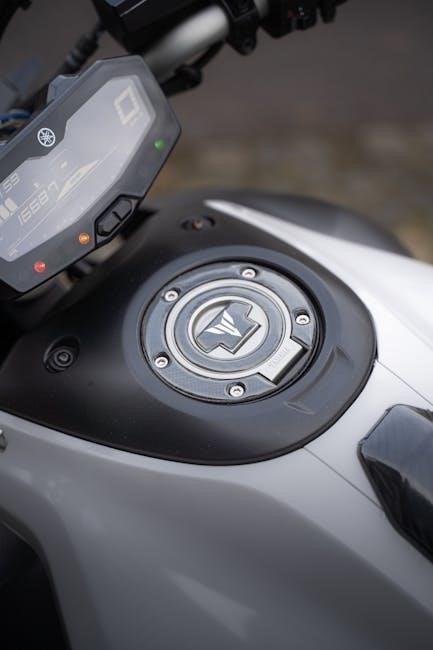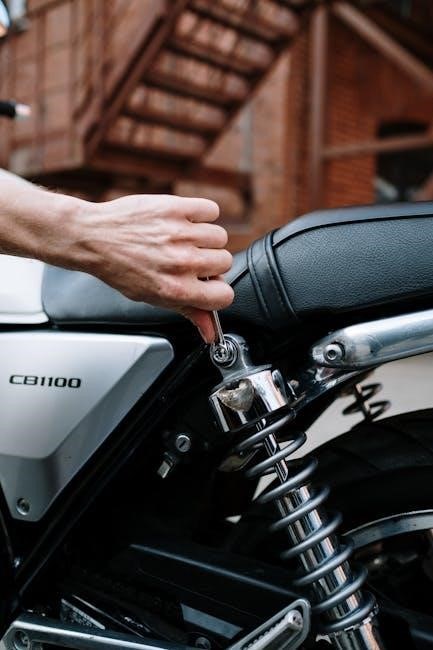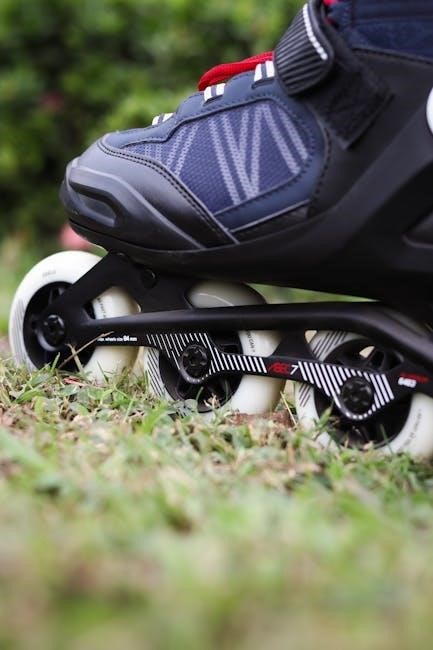The 3-speed manual transmission is a foundational gearbox offering three forward gears and one reverse. It was common in early vehicles‚ known for simplicity and fuel efficiency. Drivers appreciate its straightforward design and cost-effectiveness‚ making it a preferred choice for many classic and economy-oriented cars.
1.1 Overview of the 3-Speed Manual Transmission
The 3-speed manual transmission is a straightforward gearbox featuring three forward gears and one reverse gear. Known for its mechanical simplicity‚ it was widely used in early vehicles‚ earning the nickname “three-on-the-tree” due to its column-mounted shifter. Popular in classic cars like the Chevelle and Mustang‚ it offered reliable performance and easy maintenance‚ making it a favored choice for both economy and muscle cars.
1.2 Historical Context and Popularity
The 3-speed manual transmission gained prominence in the mid-20th century‚ becoming a staple in many classic and muscle cars of the 1960s and 1970s. Its simplicity and reliability made it a favorite among drivers. Although eventually overshadowed by 4-speed and automatic transmissions‚ it remains iconic‚ particularly in vehicles like the Chevelle and Mustang‚ symbolizing a bygone era of automotive design.

History and Evolution of the 3-Speed Manual Transmission
The 3-speed manual transmission originated with Panhard and Levassor in 1894. Ford popularized it in 1963‚ but its simplicity led to decline as 4-speeds emerged.
2.1 Early Development and Invention
The 3-speed manual transmission traces its origins to French inventors Louis-Rene Panhard and Emile Levassor in 1894‚ who introduced a chain-driven‚ three-speed design. Early versions used sliding-mesh gears‚ requiring double clutching for shifts. This primitive system laid the groundwork for modern manual transmissions‚ despite its complexity and lack of synchronization in first gear.
2.2 The Rise of the Column-Shift 3-Speed Manual
The column-shift 3-speed manual gained popularity in North America during the 1940s and 1950s‚ known for its user-friendly design. It became a standard feature in many vehicles‚ particularly early models‚ before being gradually replaced by more modern transmissions. Its enduring presence in classic cars underscores its historical significance in automotive evolution.
Types of 3-Speed Manual Transmissions
The 3-speed manual transmission comes in two primary designs: column-shift and floor-shift. Each offers distinct advantages‚ with column-shift being more compact and floor-shift providing better driver control.
3.1 Column-Shift vs. Floor-Shift Designs
The column-shift 3-speed manual transmission‚ mounted on the steering column‚ was common in 1940s-1950s North America. It offered a compact design but required double-clutching for downshifting. The floor-shift design‚ introduced later‚ provided better driver control and became popular in muscle cars‚ offering a sportier feel and easier usability‚ especially with synchronized gears.
3.2 Heavy-Duty Models and Specialized Applications
Heavy-duty 3-speed manuals‚ like Ford’s Toploader‚ were built for strength and durability‚ serving in high-performance and specialized roles. The A230 and A833 transmissions‚ known for their robustness‚ were often used in demanding applications. Specialized models‚ such as the Lenco CS4‚ catered to racing and heavy-duty needs‚ showcasing the versatility of 3-speed designs in niche markets and performance vehicles.
Technical Aspects of the 3-Speed Manual
The 3-speed manual features a gearbox with three forward and one reverse gear. Components include a clutch‚ gear sets‚ and synchromesh mechanisms for smooth shifting. Heavy-duty models‚ like the Ford Toploader‚ emphasize strength and durability‚ while designs like the Saginaw transmission highlight compact engineering for smaller engines.
4.1 Components and Internal Mechanics
The 3-speed manual transmission consists of a gear set‚ bearings‚ input shaft‚ and output shaft. Synchronizers facilitate smooth gear engagement‚ while the clutch connects and disconnects power. Internal components like the gear train and shift forks enable precise ratio changes. The Toploader design emphasizes durability‚ while the Saginaw transmission offers a compact‚ lightweight configuration for smaller engines‚ each optimizing performance for specific applications.
4.2 Gear Ratios and Performance Characteristics
The 3-speed manual transmission typically features gear ratios optimized for specific driving conditions. Common ratios include 2.77 or 3.03 for the first gear‚ providing strong acceleration. Higher gears often have a 1:1 ratio for efficient cruising. These configurations balance torque delivery and fuel efficiency‚ catering to both city driving and highway performance‚ with the Toploader and Saginaw transmissions exemplifying these characteristics.
4.3 The Role of Double Clutching
Double clutching was a necessary technique for non-synchronized first gears in early 3-speed manuals. It involved pressing the clutch twice to shift gears smoothly‚ ensuring proper alignment. This method prevented gear grinding and extended transmission life‚ particularly in heavy-duty models. Though less common in modern vehicles‚ it remains a skill associated with classic driving experiences.

Advantages and Challenges of the 3-Speed Manual
The 3-speed manual offers fuel efficiency‚ simplicity‚ and cost-effectiveness‚ making it ideal for lightweight vehicles. However‚ it lacks modern features like low-end torque and smooth shifting in heavy traffic.
5.1 Benefits of the 3-Speed Manual Transmission
The 3-speed manual transmission offers simplicity‚ fuel efficiency‚ and reliability‚ making it ideal for lightweight vehicles. Its straightforward design reduces production costs and maintenance needs. The lightweight construction enhances fuel economy‚ especially in smaller engines. It is also cost-effective and easy to repair‚ appealing to car enthusiasts and restorers seeking a mechanically simple transmission.
5.2 Limitations and Driver Demands
The 3-speed manual transmission has limited gear ratios‚ reducing flexibility in diverse driving conditions. Early models often lacked synchromesh‚ requiring double clutching‚ which is mechanically demanding. It demands more driver engagement and skill‚ especially in traffic. Its simplicity‚ while cost-effective‚ makes it less suitable for heavy-duty or high-performance applications compared to modern transmissions with more gears and advanced features.

Applications in Classic and Muscle Cars
The 3-speed manual transmission was widely used in classic Chevrolet and Ford models‚ such as the Chevelle and Mustang‚ during the 1960s and early 1970s. Its simplicity and fuel efficiency made it a standard choice for many iconic muscle cars of the era.
6.1 The 3-Speed Manual in Iconic Muscle Cars
The 3-speed manual transmission was a staple in many iconic muscle cars of the 1960s and 1970s. Models like the Chevrolet Chevelle and Ford Mustang often featured this gearbox‚ pairing it with powerful engines to deliver a driving experience that emphasized simplicity and direct control. Its lightweight design and ease of use made it a favorite among enthusiasts.
6.2 Use in Early Chevrolet and Ford Models
Early Chevrolet models‚ such as the Chevelle‚ frequently featured the 3-speed manual transmission as a standard option from 1964 to 1972. Similarly‚ Ford utilized the 3-speed in models like the Mustang‚ with the Toploader design becoming synonymous with durability. These transmissions were praised for their simplicity and cost-effectiveness‚ making them integral to the driving experience of classic American vehicles.
Modern Usage and Relevance
The 3-speed manual transmission‚ while less common today‚ retains niche appeal among classic car enthusiasts and restorers. Its simplicity and nostalgic charm make it a cherished option in vintage vehicle restorations‚ offering a direct connection to the driving experience of earlier eras.
7.1 The 3-Speed Manual in Contemporary Vehicles
While largely overshadowed by modern transmissions‚ the 3-speed manual remains relevant in niche applications‚ such as classic car restorations and off-road vehicles. Its simplicity and durability make it a preferred choice for enthusiasts seeking a lightweight‚ cost-effective gearbox. Some contemporary vehicles‚ particularly those with smaller engines‚ still utilize 3-speed manuals for their mechanical simplicity and nostalgic appeal.
7.2 Niche Applications and Enthusiast Interest
The 3-speed manual remains popular among enthusiasts for its simplicity and nostalgic appeal. It’s often sought for classic car restorations and niche applications like off-road vehicles or racing. Companies like Tremec offer conversion kits‚ enabling modern drivers to retain the charm of a 3-speed in upgraded builds. This enduring interest highlights its timeless mechanical elegance.

Maintenance and Restoration Tips
Regular maintenance is key to extending the life of a 3-speed manual; Check gear oil levels‚ inspect for wear‚ and adjust components as needed. Restoration involves disassembling safely‚ replacing worn parts‚ and ensuring proper alignment. Always reference original service manuals for authenticity and optimal performance.
8.1 Common Issues and Repair Considerations
Common issues with 3-speed manuals include worn synchronizers‚ leaking side covers‚ and noisy bearings. Shifting difficulties‚ especially in non-synchronized first gear‚ can arise from improper double-clutching. Repair often involves replacing worn components like gaskets and seals. Proper disassembly and alignment during reassembly are critical to ensure smooth operation. Regular inspection and lubrication can prevent major faults.
8.2 Best Practices for Longevity
Regular lubrication and inspection of seals and gaskets are essential to maintain the 3-speed manual transmission. Avoid aggressive clutch riding and ensure proper gear engagement. Periodic fluid checks and timely replacement of worn components prevent major repairs. Consistent maintenance and gentle driving habits extend the lifespan of this durable yet straightforward gearbox design.
Comparisons with Other Transmissions
The 3-speed manual transmission is compared to 4-speed manuals and automatics‚ offering fewer gears but being lighter and simpler for vintage cars.
9.1 3-Speed vs. 4-Speed Manual Transmissions
The 3-speed manual transmission is simpler and lighter than the 4-speed‚ often used in smaller engines for fuel efficiency. The 4-speed offers more gear ratios‚ improving acceleration and performance‚ especially in muscle cars. While the 3-speed is more straightforward‚ the 4-speed provides better control over engine RPMs‚ making it preferred for driving enthusiasts and high-performance vehicles.
9.2 3-Speed Manual vs. Automatic Transmissions
The 3-speed manual is simpler‚ lighter‚ and more fuel-efficient‚ often found in classic cars. It requires driver engagement‚ like double clutching. Automatics offer smooth‚ effortless shifting but are heavier and less efficient. Manuals are preferred for their connection to driving‚ while automatics prioritize convenience‚ making them ideal for different driving styles and vehicle purposes.
The 3-speed manual transmission holds a cherished place in automotive history‚ offering simplicity and a distinct driving experience. Its legacy endures among enthusiasts‚ with potential for niche revivals in modern vehicles‚ blending classic charm with contemporary needs.
10.1 Legacy of the 3-Speed Manual
The 3-speed manual transmission left an indelible mark on automotive history‚ celebrated for its simplicity‚ durability‚ and role in classic vehicles. Its mechanical elegance and direct driver connection endeared it to enthusiasts. Though overtaken by modern gearboxes‚ it remains a cherished relic‚ often sought by restorers and collectors‚ embodying the essence of early motoring experiences.
10.2 Potential for Revival in Modern Vehicles
While modern vehicles favor advanced transmissions‚ the 3-speed manual’s simplicity and nostalgic appeal could see niche revivals. Enthusiasts and retro-inspired designs might embrace its mechanical purity. Lightweight or retro-styled cars could benefit‚ offering a unique driving experience. However‚ its limited gear range makes broad adoption unlikely‚ confining it to specialized or vintage-inspired applications where driver engagement is prioritized over convenience.
